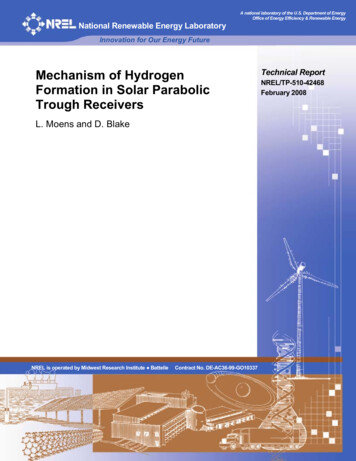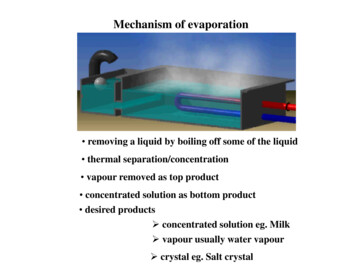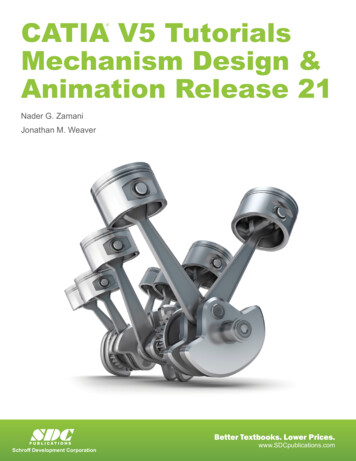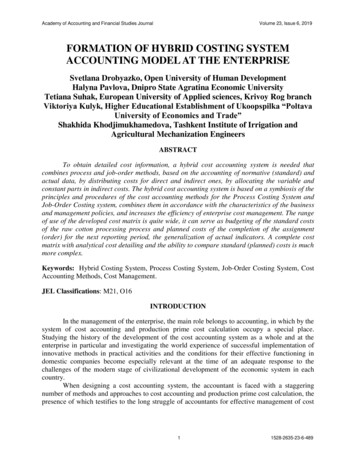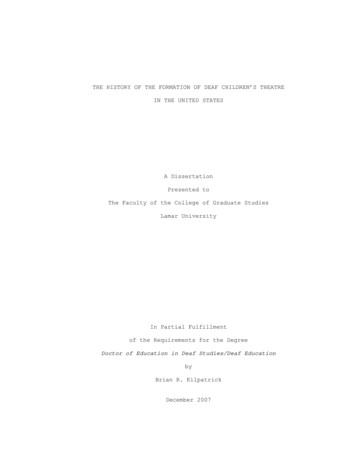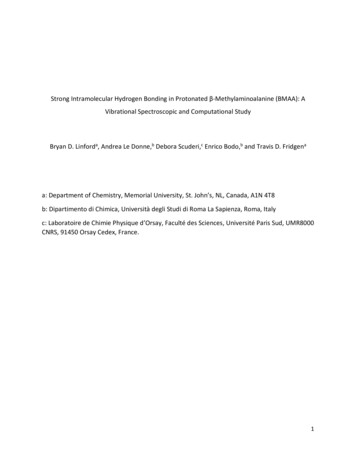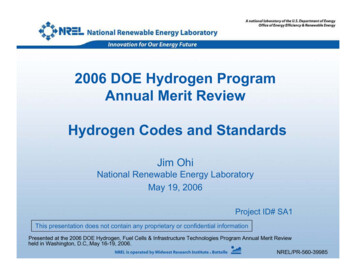
Transcription
2008 14th Biennial CSP SolarPACES (Solar Power and Chemical Energy Systems) Symposium, 4-7 March 2008, Las Vegas, Nevada (CD-ROM) (NREL/CD-550-42709)MECHANISM OF HYDROGEN FORMATION IN SOLAR PARABOLICTROUGH RECEIVERS *Luc MoensDaniel M. BlakeNational Renewable Energy Laboratory. Senior Scientist – Ph.D.National Renewable Energy Laboratory. Principal Scientist – Ph.D.National Renewable Energy Laboratory, 1617 Cole Boulevard, Golden, Colorado 80401, USA.303-384-6265; luc moens@nrel.govAbstractSolar parabolic trough systems for electricity production are receiving renewed attention, and new solar plantsare under construction to help meet the growing demands of the power market in the Western United States. Thegrowing solar trough industry will rely on operating experience it has gained over the last two decades.Recently, researchers found that trough plants that use organic heat transfer fluids (HTF) such as Therminol VP-1are experiencing significant heat losses in the receiver tubes. The cause has been traced back to theaccumulation of excess hydrogen gas in the vacuum annulus that surrounds the steel receiver tube, thuscompromising the thermal insulation of the receiver. The hydrogen gas is formed during the thermaldecomposition of the organic HTF that circulates inside the receiver loop, and the installation of hydrogen gettersinside the annulus has proven to be insufficient for controlling the hydrogen build-up over the lifetime of thereceivers. This paper will provide an overview of the chemical literature dealing with the thermal decompositionof diphenyl oxide and biphenyl, the two constituents of Therminol VP-1.Keywords: parabolic trough receivers; hydrogen; heat transfer fluid; diphenyl oxide; biphenyl1IntroductionSolar parabolic trough systems for electric power production have been operating in the Western United Statesfor over two decades, and new trough plants are currently under construction to help meet the growing demandsof the power market. i These solar plants consist of large fields of modular parabolic trough collectors thatcapture and focus the sensible solar heat radiation onto a linear receiver tube that is placed in the focal line of theparabolic trough collectors. A heat transfer fluid (HTF) circulates through the receiver tube, and transports thethermal energy to a heat exchanger system in a power block where high-pressure superheated steam is generated.This steam is then used to drive a steam turbine/generator to produce electricity. The receiver tube loop that runsthrough the solar field is made up of a modular series of heat collection elements (HCE). Each HCE iscomposed of a steel tube that contains the HTF, and an outer glass tube that maintains a vacuum around the hotsteel tube. This vacuum annulus serves as a thermal insulator while allowing for maximum absorption of thesolar thermal radiation by each HCE.Researchers have tested several types of heat transfer fluids in solar fields, e.g., mineral oils, silicones, heavyaromatic oils, and molten salts. Among these, the most cost-effective and most practical organic oil is thatcomposed of a eutectic mixture of diphenyl oxide (DPO, or (di)phenyl ether) and biphenyl, which is betterknown under the trademark names of Therminol VP-1 or Dowtherm A.1,ii The eutectic formulation is composedof 73.5% DPO and 26.5% biphenyl, and has a pour point of 12 C (Fig. 1).Odiphenyl oxidebiphenylFigure 1. Components of Therminol VP-1 and Dowtherm A*This work has been authored by an employee of the Midwest Research Institute under Contract No. DE-AC36-99GO10337 with the U.S.Department of Energy. The United States Government retains and the publisher, by accepting the article for publication, acknowledges thatthe United States Government retains a non-exclusive, paid-up, irrevocable, worldwide license to publish or reproduce the published formof this work, or allow others to do so, for United States Government purposes.
2008 14th Biennial CSP SolarPACES (Solar Power and Chemical Energy Systems) Symposium, 4-7 March 2008, Las Vegas, Nevada (CD-ROM) (NREL/CD-550-42709)In spite of the relatively low boiling point of this oil (257 C) it has been used successfully in commercial solartrough plants at operating temperatures as high as 400 C for many years. Yet, even though this has led to veryreliable and continuous power production for two decades, recent observations in several solar fields haverevealed significant heat losses in a large number of HCE modules. These thermal losses have been attributed tothe slow permeation of traces of hydrogen gas through the steel tube wall into the vacuum annulus of severalHCE modules thereby compromising the thermal insulation capacity of the annulus.Since the construction of the first solar trough systems two decades ago, it has been common practice amongmanufacturers of receiver tubes to incorporate so-called “hydrogen getters” inside the vacuum space of eachHCE. These absorb any traces of hydrogen gas that might be formed over time as a result of thermal degradationof the HTF. Recent observations, however, indicate that the long-term exposure of the organic HTF to 400 Ctemperatures can lead to hydrogen pressures that exceed the gas-absorbing capacity of the hydrogen getters,thereby causing the significant heat losses that are currently observed in several solar trough plants.This problem is gaining considerable importance as the trough industry is examining new technologies to drivethe cost of electricity down. These include thermal energy storage to increase the efficiency of current as well asfuture plant designs. In an effort to better understand the causes of the hydrogen gas formation and also todevelop possible strategies for mitigating the gas build-up, this paper presents a review of the most relevantchemical and patent literature relating to the thermal decomposition of biphenyl and diphenyl oxide. Ourintention is to gather literature data that support the notion that the hydrogen formation proceeds at temperaturesaround 400 C as a result of thermal degradation of the organic HTF.22.1Literature ReviewThermal decomposition of biphenyl and DPOSince the 1930s researchers have known that the thermal decomposition of biphenyl and DPO above 400 C,results in the formation of tar-like materials with very high melting points (ca. 200 C) that were then touted asthermally stable heat transfer fluids. iii,iv At that time, the composition of the thermal product mixture could notbe determined due to the lack of appropriate analytical tools.During the early 1960s, more details became available regarding the thermal decomposition of pure biphenyl at425 C as this compound was regarded as a potentially useful coolant for nuclear reactors. This temperature wasfound to be sufficient to cause pyrolytic decomposition with formation of a gaseous mixture that containedhydrogen in addition to carbon monoxide and C1-C3 hydrocarbons. v,vi The reaction mixture also containedaromatic hydrocarbons such as benzene, terphenyl, and quaterphenyls. The formation of these polyphenylsclearly indicated that polymerization of the phenyl groups plays a significant role in the pyrolysis of biphenyl.Shortly thereafter, two significant studies were published wherein Dowtherm A was investigated as a workingfluid for potential use in Rankine cycle power systems. vii,viii This work showed that circulating this fluid in a testloop kept at 700 F (371 C) for 10,000 hours, resulted in the measurable build-up of gaseous products above thefluid, which again included hydrogen. In addition, aromatic degradation products such as benzene, phenol andterphenyls were identified among the reaction products. Considering that the Dowtherm A sold today is rated foroperating temperatures as high as 400 C, it appears that other factors may have caused the degradation. As wewill discuss later, the presence of impurities in the fluid may have been the culprit.Because of the challenges associated with measuring thermal decomposition rates at 400-450 C, Proksch et al.conducted a systematic kinetic study of the thermal decomposition of pure biphenyl under strict control of thereaction conditions. ix They found that the careful exclusion of oxygen from the pyrolysis reactor and followingthe kinetics for thermal decomposition of 1% of the biphenyl sample were the keys to obtaining consistentresults. Because the thermal decomposition of biphenyl at 400 C was considered too slow for a practical kineticstudy in the laboratory, the thermal decomposition study was carried out at temperature increments between420 C and 465 C. At 1% conversion of the biphenyl the formation of secondary reaction products was avoidedand a rate expression for the initial thermal degradation could be derived as a function of temperature using afirst-order kinetics approach (Eq. 1):log V 20.59 – (15,770/T)(Eq. 1)
2008 14th Biennial CSP SolarPACES (Solar Power and Chemical Energy Systems) Symposium, 4-7 March 2008, Las Vegas, Nevada (CD-ROM) (NREL/CD-550-42709)where V is the rate of the pyrolysis in %/h for low conversions of liquid biphenyl, and T is the temperature (K).Assuming first-order kinetics, this rate expression can be transformed into Equation 2:log k 15.03 – (15,770/T)(Eq. 2)wherein k is the first-order rate of the pyrolysis in s-1. Using this approach, an Arrhenius activation energy of302 kJ/mol (72.1 kcal/mol) was derived. Analysis of the pyrolysis mixture revealed the formation of hydrogengas, and a mixture of benzene, terphenyl, and quaterphenyl isomers. Interestingly, the concentration of benzenein the aromatic fraction increased from less than 5% at 420 C for 150 h, to 23% at 465 C in 6 h, thereby clearlydemonstrating the rapid breakdown of biphenyl within a relatively small temperature range above 420 C.The cleavage of the strong carbon-carbon single bond in biphenyl was also of great interest to the fossil fuelindustry since this aromatic structure is common to some of the most thermally stable compounds in coal andpetroleum-derived aromatic streams. Extensive studies during the 1990s demonstrated that heating a mixture ofbiphenyl and alkanes at 450 C resulted in the rapid thermal decomposition of the aromatic compound. x The keystep in this process is the breakdown of the alkane which releases highly reactive hydrogen atoms that attack thebiphenyl as shown in Figure 2. The C-C bond cleavage generates a phenyl radical that can engage in a chainreaction.H Figure 2. Cleavage of biphenyl by hydrogen atomLikewise, the direct thermal cleavage of biphenyl also forms phenyl radicals, and these two steps combined canthen initiate a chain reaction. This leads to the production of benzene, polyphenyl compounds (e.g. terphenyl),and also more hydrogen atoms that ultimately recombine to form hydrogen gas (Fig. 3).10H Hterphenyl2HH2Figure 3. Radical-induced formation of polyphenyls and hydrogenIn other words, the rate of the thermal decomposition of biphenyl may be influenced by the presence of dissolvedorganic impurities, as these can act as a source of hydrogen atoms.DPO has been investigated as part of coal liquefaction research, and bond dissociation energies for the C-O bondhave been reported that range from 76 to 80 kcal/mol. xi,xii As shown in Figure 4, the homolytic dissociation ofDPO results in the formation of phenoxy and phenyl radicals, while hydrogen atoms can cause cleavage to formbenzene and a phenoxy radical in analogy with biphenyl cleavage.
2008 14th Biennial CSP SolarPACES (Solar Power and Chemical Energy Systems) Symposium, 4-7 March 2008, Las Vegas, Nevada (CD-ROM) (NREL/CD-550-42709)OOHO OFigure 4. Cleavage reactions of DPO2.2Thermal decomposition of DPO/biphenyl mixturesConsidering the multitude of reactions that the radical species can engage in, the product slate generated from amixture of DPO and biphenyl can be expected to be even more complex. We found only one report thatdescribes a study of the thermal degradation of Dowtherm A in a temperature range of 400-425 C, and thatprovides some insight into the overall kinetics as well as the products formed during the fluid breakdown. xiii Itwas found that under static conditions the fluid viscosity increased by 17% at 425 C after 120 h, and thisempirical approach suggested that the thermal breakdown of this aromatic mixture involved a polymerizationprocess. The presence of heavier degradation products was confirmed through the use of gel permeationchromatography (GPC). Moreover, a linear correlation was found between the quantitative GPC analysis ofthese heavy products and the viscosity of the fluid after heating at 400 C, 412.5 C, and 425 C, respectively.Using a first-order kinetic approach, an activation energy of 72 kcal/mol was calculated that fit well with thethermochemical data mentioned earlier for biphenyl. When Dowtherm A was heated at 425 C for 120 h, about8% of the fluid had degraded to form a mixture of a) gaseous products consisting of hydrogen gas (44% of thetotal gas volume) and small hydrocarbons, and b) a fraction containing the aromatic compounds shown in Figure5.OHOOHOOOFigure 5. Aromatic compounds formed during thermal breakdown of Dowtherm AMuch heavier aromatics were detected during the GPC analysis, but their structures were not determined.Nevertheless, this work led to the formulation of a plausible mechanistic scheme that explains the formation ofhydrogen gas as a significant by-product, as well as the observed aromatic products (Fig. 6).
2008 14th Biennial CSP SolarPACES (Solar Power and Chemical Energy Systems) Symposium, 4-7 March 2008, Las Vegas, Nevada (CD-ROM) (NREL/CD-550-42709)InitiationPh-O-PhPh PhO2 PhPh-PhPropagationPh Ph-O-PhPhH Ph-O-C6H4Ph Ph-PhPhH Ph-C6H4Ph Ph-O-PhPhO Ph-O-PhH Ph-O-PhPhH PhOH Ph-PhPhH PhPh-C6H4-O-PhPhOH HPh-O-C6H4Termination2 Ph-O-C6H42 C6H5Ph H2HPh-O-C6H4-C6H4-O-PhPh-PhPhHH2Figure 6. Proposed mechanism for thermal breakdown of DPO/biphenyl mixtures(Ph-O-Ph DPO; Ph-P
Components of Therminol VP-1 and Dowtherm A * This work has been authored by an employee of the Midwest Research Institute under Contract No. DE-AC36-99GO10337 with the U.S. Department of Energy. The United States Government retains and the publisher, by accepting the article for publication, acknowledges that the United States Government retains a non-exclusive, paid-up, irrevocable .
